China's first two satellites
or - Did it ever occur to you how similar
to Telstar-1 they look?
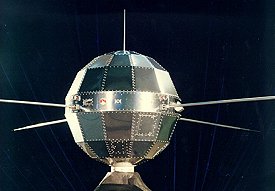 The
launch of China's first satellite on 24 April, 1970 was a significant
event
in the histroy of spaceflight. Little did we understand then that this
would lead to China being a major player in the commercial space field.
Most of us came to regard the first satellite (called DFH-1 nowadays)
as
a test satellite with a simple telemetry system transmitter on 20 MHz
which
also transmitted the tune "The East
is
Red" (Dong Fang Hung = DFH). However, that impression was all wrong.
The
launch of China's first satellite on 24 April, 1970 was a significant
event
in the histroy of spaceflight. Little did we understand then that this
would lead to China being a major player in the commercial space field.
Most of us came to regard the first satellite (called DFH-1 nowadays)
as
a test satellite with a simple telemetry system transmitter on 20 MHz
which
also transmitted the tune "The East
is
Red" (Dong Fang Hung = DFH). However, that impression was all wrong.
Let me describe to you
a
visit to the Beijing Institute of Control Engineering in 1986. Here is
an extract from my diary:
".....After the
initial
niceties and general presentation they showed us around their little
exhibition.
The first item was shock for me: They threw a switch on a little box
and
all of a sudden the tune "DongFangHung"
(The
East is Red) plus the typical telemetry from the first Chinese
satellite
came out of a speaker next to the box. The box had a picture of
Chairman
Mao on one side. The picture was surrounded by yellow "rays of light"
painted
on the box. The institute had made the telemetry system for China 1 and
2 and the box on the table was the prototype!....
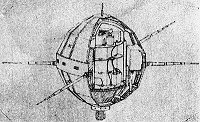 ....After
the Control Engineering Institute we were taken to a satellite
integration
building just nearby.....we were shown the engineering model of the
first
Chinese geostationary communications satellite, STW-1, and full-scale,
accurate, mockups of China 1 and 2. The China 2 mockup could be
disassembled.
The top came off an reveraled a hermetic container inside. This
container
was pressurized to 0.1 atmospheres and is a cylinder about 0.8 m long
and
0.5 m in diameter (see picture on the left from the Chinese book
"Dangdai
Zhongguo de Hangtian Shiye" published in 1986). Its axis is
perpendicular
to the plane of the shortwave antennas. Around the "waist" of the the
cylinder
is an annular box covering roughly 270 deg of the circumference of the
cylinder. This box has a louvre system on one end.
....After
the Control Engineering Institute we were taken to a satellite
integration
building just nearby.....we were shown the engineering model of the
first
Chinese geostationary communications satellite, STW-1, and full-scale,
accurate, mockups of China 1 and 2. The China 2 mockup could be
disassembled.
The top came off an reveraled a hermetic container inside. This
container
was pressurized to 0.1 atmospheres and is a cylinder about 0.8 m long
and
0.5 m in diameter (see picture on the left from the Chinese book
"Dangdai
Zhongguo de Hangtian Shiye" published in 1986). Its axis is
perpendicular
to the plane of the shortwave antennas. Around the "waist" of the the
cylinder
is an annular box covering roughly 270 deg of the circumference of the
cylinder. This box has a louvre system on one end.

The most striking
features
about China 1 and 2 which I immediately noticed was that both
satellites
has a set of dipoles in small cavities around the "equator". The
dipoles
have different lengths. One set seems to be about 50% longer than the
other
set. ...Behind the dipoles there were coax cables connecting the
dipoles
in some kind of network. it is impossible to avoid the conclusion that
these antennas serve some kind of C-band transponder system. the only
other
devices protruding from the satellite (except the 4 HF whips) is a
short
stubby antenna along the equator with a frequency in the UHF (?) range
and a VHF quarter-wave rod on the top of the satellite. No scientific
sensors
can be seen 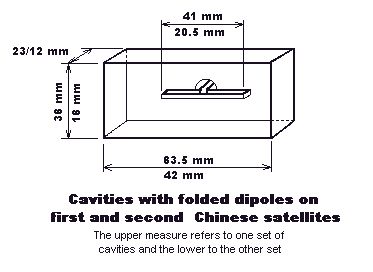 anywhere.
So, I said to Mr....and a fellow from CAST (Chinese Academey of Space
Technology):
'It seems to me that the first two satellites were communications test
satellites'. 'Yes', they confirmed, 'we would never launch satellites
just
to play a tune'............".
anywhere.
So, I said to Mr....and a fellow from CAST (Chinese Academey of Space
Technology):
'It seems to me that the first two satellites were communications test
satellites'. 'Yes', they confirmed, 'we would never launch satellites
just
to play a tune'............".
About a year later a
model
of China 1 was displayed at the Paris Air Show and enterprising persons
measured the size of the cavities (see drawing on the left) and the
folded
dipoles in them. The size ratio is almost exactly a factor of two. In a
submission to the International Frequency Registration Board (IFRB) (See
table below) the Chinese authorities have indicated that the
downlink
frequency was 5600 MHz transmitted at +13 dBW EIRP (i.e. 20 Watts) with
LHC polarization. Let us assume that the smaller of the cavities refer
to this frequency. Then the larger cavity would correspond to half that
frequency, or about 2800 MHz.
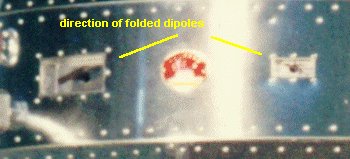 Surprisingly
enough the Chinese have given the frequency 2752 MHz for a link transmitted
at -3 dBW (0.5 W). This frequency is near the frequencies used by the
Chinese
S-band tracking radar system used on launch vehicles and satellites
alike.
So, perhaps the 2752 MHz signal was an acquistion beacon for the radar
stations. Also, maybe larger cavity was used both for the 2752 MHz
downlink,
for the S-band radar and for a 2.8 GHz uplink to the 5.6 GHz
communications
downlink? Strangely enough the IFRB circular gives 5600 MHz RHC for
the uplink. It is impossible that the little cavities can support both
polarizations. If you look closely you can see that the little folded
dipoles
are mounted diagonally in the cavities and that the larger cavity and
the
small capity dipoles are slanted in opposite directions! Therefore, it
could be possible that the larger cavities are also resonant at 5.6
GHz!
However, there has to be some frequency offset between receive and
transmit
in the 5.6 GHz band.
Surprisingly
enough the Chinese have given the frequency 2752 MHz for a link transmitted
at -3 dBW (0.5 W). This frequency is near the frequencies used by the
Chinese
S-band tracking radar system used on launch vehicles and satellites
alike.
So, perhaps the 2752 MHz signal was an acquistion beacon for the radar
stations. Also, maybe larger cavity was used both for the 2752 MHz
downlink,
for the S-band radar and for a 2.8 GHz uplink to the 5.6 GHz
communications
downlink? Strangely enough the IFRB circular gives 5600 MHz RHC for
the uplink. It is impossible that the little cavities can support both
polarizations. If you look closely you can see that the little folded
dipoles
are mounted diagonally in the cavities and that the larger cavity and
the
small capity dipoles are slanted in opposite directions! Therefore, it
could be possible that the larger cavities are also resonant at 5.6
GHz!
However, there has to be some frequency offset between receive and
transmit
in the 5.6 GHz band.
Be this as it may,
China
1 and 2 were intended for telecommunications tests, but it comes as
something
of a surprise how closely they resemble the Telstar1 and 2 satellites
(See
pictures below).
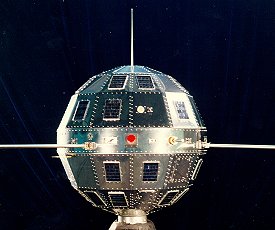
China-2 (photo:
Ministry
of Astronautics,Beijing)
|
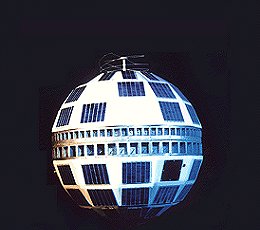
Telstar 1
|
The frequencies listed
in
the table below contain more surprises. The 202 MHz low-powered signal
may have been used for interferoemter tracking only, but may also have
contained telemetry. Later Chinese satellites have had a telemetry
transmitter
on 180 MHz. That the shortwave tranmitters were rather strong (2.5-3
Watts)
was certainly evident from what was observed by myself and other space
listeners at the time.
Link
Nr |
Downlink
frequency
(MHz) |
DFH-1
(China 1)
|
SJ-1
(China 2) |
| A |
19.997
|
- |
+4.0
dBW |
| B |
20.008
|
+4.0
dBW |
+4.8
dBW |
| C |
202
|
-5.0
dBW |
-5.2
dBW |
| D |
2752
|
-3.0
dBW
RHC |
-3.0
dBW
RHC |
| E |
5600
|
+13.0
dBW
RHC |
+13.0
dBW
RHC |
The Kettering Group
measured
the HF frequencies to be 19.995 and 20.009 MHz.

 Back
to Space History Notes
Back
to Space History Notes
 ....After
the Control Engineering Institute we were taken to a satellite
integration
building just nearby.....we were shown the engineering model of the
first
Chinese geostationary communications satellite, STW-1, and full-scale,
accurate, mockups of China 1 and 2. The China 2 mockup could be
disassembled.
The top came off an reveraled a hermetic container inside. This
container
was pressurized to 0.1 atmospheres and is a cylinder about 0.8 m long
and
0.5 m in diameter (see picture on the left from the Chinese book
"Dangdai
Zhongguo de Hangtian Shiye" published in 1986). Its axis is
perpendicular
to the plane of the shortwave antennas. Around the "waist" of the the
cylinder
is an annular box covering roughly 270 deg of the circumference of the
cylinder. This box has a louvre system on one end.
....After
the Control Engineering Institute we were taken to a satellite
integration
building just nearby.....we were shown the engineering model of the
first
Chinese geostationary communications satellite, STW-1, and full-scale,
accurate, mockups of China 1 and 2. The China 2 mockup could be
disassembled.
The top came off an reveraled a hermetic container inside. This
container
was pressurized to 0.1 atmospheres and is a cylinder about 0.8 m long
and
0.5 m in diameter (see picture on the left from the Chinese book
"Dangdai
Zhongguo de Hangtian Shiye" published in 1986). Its axis is
perpendicular
to the plane of the shortwave antennas. Around the "waist" of the the
cylinder
is an annular box covering roughly 270 deg of the circumference of the
cylinder. This box has a louvre system on one end.
 The
launch of China's first satellite on 24 April, 1970 was a significant
event
in the histroy of spaceflight. Little did we understand then that this
would lead to China being a major player in the commercial space field.
Most of us came to regard the first satellite (called DFH-1 nowadays)
as
a test satellite with a simple telemetry system transmitter on 20 MHz
which
also transmitted the tune "The East
is
Red" (Dong Fang Hung = DFH). However, that impression was all wrong.
The
launch of China's first satellite on 24 April, 1970 was a significant
event
in the histroy of spaceflight. Little did we understand then that this
would lead to China being a major player in the commercial space field.
Most of us came to regard the first satellite (called DFH-1 nowadays)
as
a test satellite with a simple telemetry system transmitter on 20 MHz
which
also transmitted the tune "The East
is
Red" (Dong Fang Hung = DFH). However, that impression was all wrong.

 anywhere.
So, I said to Mr....and a fellow from CAST (Chinese Academey of Space
Technology):
'It seems to me that the first two satellites were communications test
satellites'. 'Yes', they confirmed, 'we would never launch satellites
just
to play a tune'............".
anywhere.
So, I said to Mr....and a fellow from CAST (Chinese Academey of Space
Technology):
'It seems to me that the first two satellites were communications test
satellites'. 'Yes', they confirmed, 'we would never launch satellites
just
to play a tune'............".
 Surprisingly
enough the Chinese have given the frequency 2752 MHz for a link transmitted
at -3 dBW (0.5 W). This frequency is near the frequencies used by the
Chinese
S-band tracking radar system used on launch vehicles and satellites
alike.
So, perhaps the 2752 MHz signal was an acquistion beacon for the radar
stations. Also, maybe larger cavity was used both for the 2752 MHz
downlink,
for the S-band radar and for a 2.8 GHz uplink to the 5.6 GHz
communications
downlink? Strangely enough the IFRB circular gives 5600 MHz RHC for
the uplink. It is impossible that the little cavities can support both
polarizations. If you look closely you can see that the little folded
dipoles
are mounted diagonally in the cavities and that the larger cavity and
the
small capity dipoles are slanted in opposite directions! Therefore, it
could be possible that the larger cavities are also resonant at 5.6
GHz!
However, there has to be some frequency offset between receive and
transmit
in the 5.6 GHz band.
Surprisingly
enough the Chinese have given the frequency 2752 MHz for a link transmitted
at -3 dBW (0.5 W). This frequency is near the frequencies used by the
Chinese
S-band tracking radar system used on launch vehicles and satellites
alike.
So, perhaps the 2752 MHz signal was an acquistion beacon for the radar
stations. Also, maybe larger cavity was used both for the 2752 MHz
downlink,
for the S-band radar and for a 2.8 GHz uplink to the 5.6 GHz
communications
downlink? Strangely enough the IFRB circular gives 5600 MHz RHC for
the uplink. It is impossible that the little cavities can support both
polarizations. If you look closely you can see that the little folded
dipoles
are mounted diagonally in the cavities and that the larger cavity and
the
small capity dipoles are slanted in opposite directions! Therefore, it
could be possible that the larger cavities are also resonant at 5.6
GHz!
However, there has to be some frequency offset between receive and
transmit
in the 5.6 GHz band.

